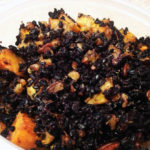Michael Jackson might have said “it doesn’t matter if you’re black or white”, but what about when it comes to rice? Ok, ok…I’ll stop trying to sing and dance like MJ now. Especially his signature “hee-hee!” Side note – one thing I know for sure is, you do not want me to serenade your dinner party LOL, I’m better kept in the kitchen, trust me! Ok anyway, back to rice.
I’m about to school you all. Many people don’t know this, but there is such a thing as black rice. Since my clients love when I make it for them, I thought this week I would talk about the importance of its color and how it is different from white rice.
Black rice (aka “Forbidden” or “Emperor’s” rice as it was served only to  emperors in ancient China) actually has more of a purple hue. In its original state, rice has a protective barrier or outermost layer, known as a bran hull. This outermost layer is removed to make white rice. Since black (and brown) rice maintains its bran hull, it is actually richer in nutrients and higher in fiber. Most notably, it has a higher level of anthocyanin antioxidants. These antioxidants are what gives it is purplish-black color, just like blueberries and other fruits. These babies are cancer fighters and help prevent cardiovascular disease and cognitive decline. Black rice is even a great source of Vitamin E! Eat up! Nom nom.
emperors in ancient China) actually has more of a purple hue. In its original state, rice has a protective barrier or outermost layer, known as a bran hull. This outermost layer is removed to make white rice. Since black (and brown) rice maintains its bran hull, it is actually richer in nutrients and higher in fiber. Most notably, it has a higher level of anthocyanin antioxidants. These antioxidants are what gives it is purplish-black color, just like blueberries and other fruits. These babies are cancer fighters and help prevent cardiovascular disease and cognitive decline. Black rice is even a great source of Vitamin E! Eat up! Nom nom.
Sensitive tummy? You might be better off sticking with your Plain Jane white rice. While black rice is more nutritious and higher in fiber, this outermost layer can actually be harsher on your digestive system.
What about wild rice, you say? Funnily enough, wild rice isn’t rice at all! It’s actually grass! It just happens also to be high in anthocyanin antioxidants, but higher in protein and fiber than black rice. Who’s the winner, now? It’s like the Superman of rice, hiding in plain sight. How about those grains?
Paleo Peeps- white rice is the only rice considered to be Paleo-approved, because it is stripped of the protective shield. You can read more on that here, http://paleoleap.com/about-rice/
Bottom line: no matter which type of rice you choose, they are all low calorie, gluten free options with important nutrients. Pick the one that suits you and your diet the best, or heck, incorporate all colors and switch it up.
For more on this subject:
http://draxe.com/forbidden-rice/ (this one has a black rice recipe, too!)
http://paleoleap.com/about-rice/
https://www.sciencedaily.com/releases/2015/09/150926191819.htm
http://www.livestrong.com/article/543493-nutrition-differences-in-black-rice-vs-brown-rice/

